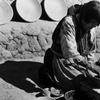Open now - Strike a Pose: Spectacular Imagery of the Kabuki Theater.
- NEW YORK, New York
- /
- September 08, 2016
During the autumn Asia Week in New York, Scholten Japanese Art will present Strike a Pose: Spectacular Imagery of the Kabuki Theater which will remain on view through New York Print Week in November.
This exhibition displays an array of imagery related to one of Japan’s most distinctive, and yet possibly least understood, cultural exports: the kabuki theater, and focuses on ukiyo-e woodblock prints portraying popular actors in lavish costumes on stage as well as relaxing off stage. While kabuki-related subjects had significant visual influence on the West, the highly stylized nature of the theater and the complexity of much of the related imagery create a barrier (both in language and in visual cues) to understanding the underlying meaning of many compositions. In addition to identifying the actors, their roles and the plays we uncover hidden meanings and explore aspects of kabuki that are often overlooked or underappreciated in the West.
The term kabuki is comprised of three characters, ka (sing), bu (dance), and ki (skill), but it was derived from the term kabuku, which means ‘to lean’ as in leaning away from the norm, or out of the ordinary, bizarre. It was used in reference to a genre of entertainment that originated in Kyoto around 1600 by a female shrine dancer known as Izumo no Okuni who would perform dances and skits with a troupe of women while cross-dressing. Her outrageous and audacious style was considered kabuku, and was wildly popular, inspiring the establishment of competing troupes. Eventually, ensembles organized by brothels appropriated the format as a front for prostitution, prompting the shogunate to ban women from the stage in 1629. The female performers were replaced by wakushu (young men) who also engaged in prostitution, resulting in a ban on wakushu from the stage in 1652, thus firmly establishing the male-only tradition of the kabuki theater.
The exhibition features approximately 70 woodblock prints supplemented by a few paintings, including a very rare kabuki signboard by Torii Kotondo (1900-1976) from the collection of the artist Paul Binnie (b. 1967). The majority of the prints will be by the most prolific kabuki artist of the 19th century, Utagawa Kunisada (Toyokuni III, 1786-1865); there will also be works by his teacher, Utagawa Toyokuni I (1769-1825), Utagawa Kuniyasu (1794-1832), Utagawa Yoshitora (active ca. 1836-1887), Toyohara Kunichika (1835-1900), and 20th century artists such as Natori Shunsen (1886-1960), Yamamora Koka (Toyonari, 1885-1942), and Shin’ei (dates unknown), with paintings by Kitano Tsunetomi (1880-1947) and Torii Kotondo.
Scholten Japanese Art, located at 145 West 58th Street, Suite 6D, is open Monday through Friday, and some Saturdays, 11am - 5pm, by appointment. To schedule an appointment please call (212) 585-0474.
For the duration of the Asia Week and Print Week segments of the exhibition, September 8 – 16, and November 1- 5, the gallery has general open hours (no appointment needed), 11 am to 5 pm; and thereafter by appointment through November 8th.
Contact:
Katherine MartinScholten Japanese Art
2125850474
info@scholten-japanese-art.com
145 West 58th Street
6D
Scholten Japanese Art, New York
admin@scholten-japanese-art.com
212 585 0474
http://www.scholten-japanese-art.com/index.php
About Scholten Japanese Art
Scholten is a private gallery specializing in Japanese woodblock prints, paintings, and netsuke. We offer ukiyo-e from the 18th to 20th centuries, including shin hanga, sosaku hanga, and Japanese-style woodblock prints produced by Western artists. Located in a spacious suite in the old Meurice Hotel, just steps from Central Park South, we enjoy meeting with visitors one on one in order to best learn about your interests and share the collection with you.
















